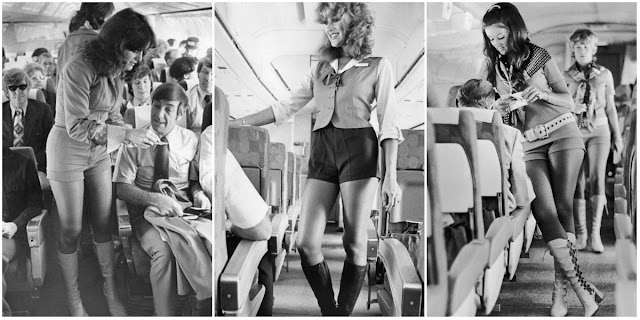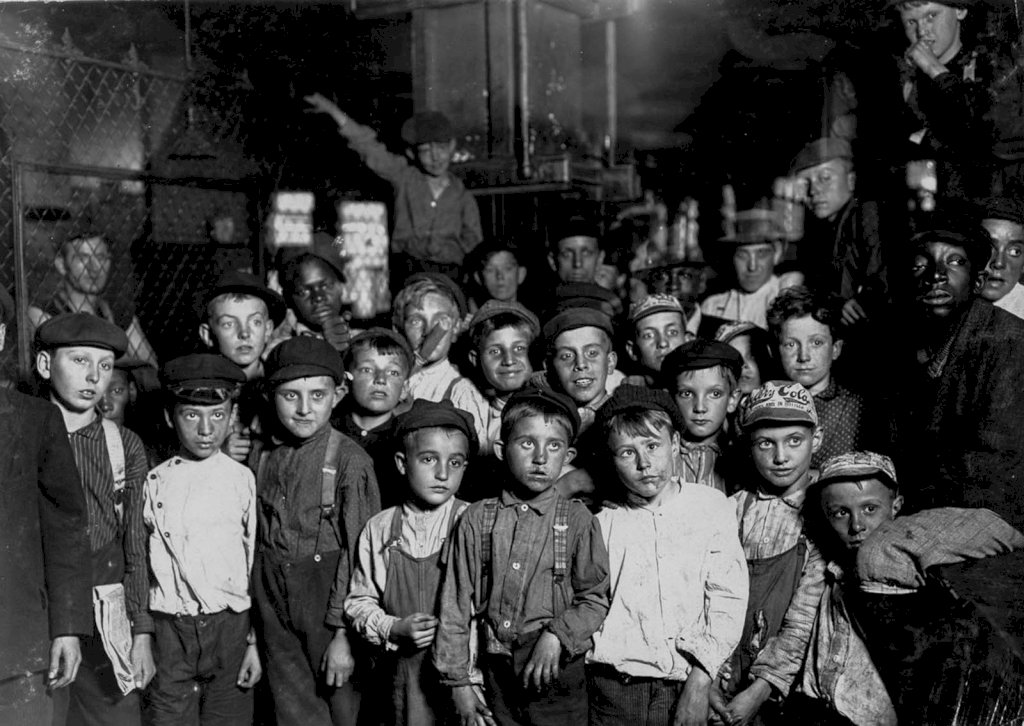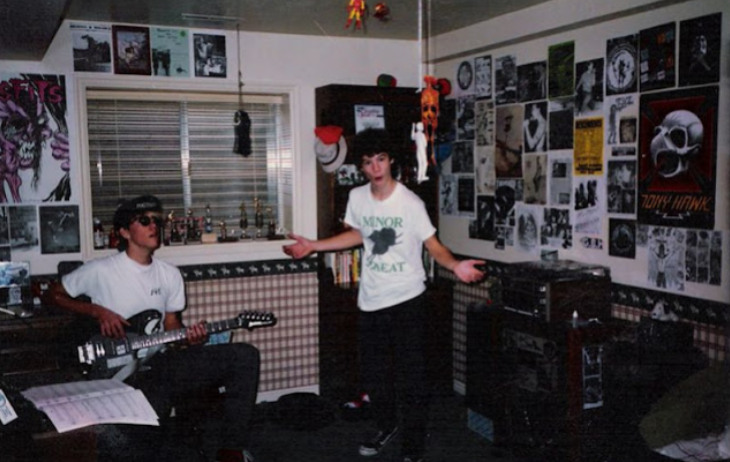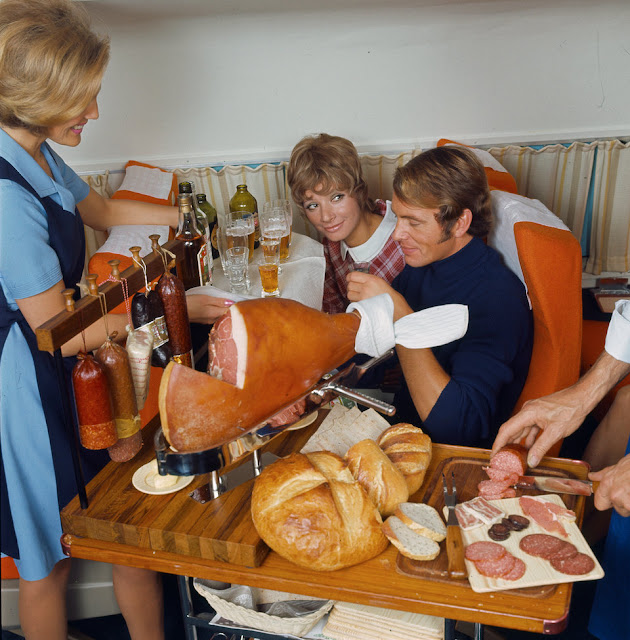By the late 1960s, the American landscape was ravaged by decades of unchecked land development, blighted by urban decay in the big cities, and plagued by seemingly unstoppable air, noise, and water pollution. In November 1971, the newly created Environmental Protection Agency (EPA) announced a monumental photodocumentary project to record changes in the American environment. DOCUMERICA resulted in a collection of more than 20,000 photographs by its conclusion in 1978. Here's a selection of color pictures of America in crisis and cure in the 1970s.
![]()
|
| Water cooling towers of the John Amos Power Plant loom over a home located across the Kanawha River, near Poca, West Virginia, in August of 1973. (Harry Schaefer/NARA) |
![]()
|
| One of four bicyclists holds her ears against the roar of the jet taking off from National Airport in Washington, D.C., in May of 1973. (John Neubauer/NARA) |
![]()
|
| Clark Avenue and Clark Avenue bridge, looking east from West 13th Street, obscured by industrial smoke, in Cleveland, Ohio, in July of 1973. (Frank J. Aleksandrowicz/NARA) |
![]()
|
| Balloon logging in the Culp Creek drainage area of Oregon, near Eugene. (NARA) |
![]()
|
| A mountain of damaged oil drums lies in a heap in an Exxon refinery near Baton Rouge, Louisiana, in December of 1972. (John Messina/NARA) |
![]()
|
| A man rides in a graffiti-covered subway car in New York City in May of 1973. (Erik Calonius/NARA) |
![]()
|
| Construction on Lower Manhattan's West Side, just north of the World Trade Center, May 1973. (Wil Blanche/NARA) |
![]() |
| Off-shore oil wells in Galveston Bay, off the Texas shore, in June of 1972. (Blair Pittman/NARA) |
![]() |
| Looking east along Alaska's Glen Highway, toward Mount Drum (Elevation 12,002 Feet) at the intersection of the highway and the under-construction Trans-Alaska Pipeline in August 1974. The 48-inch diameter pipeline will cross the roadway between the two vehicles. The exact point is marked by a pair of wooden stakes along the right shoulder at Mile 673. (Dennis Cowals/NARA) |
![]() |
| Prospect Creek Camp, lower foreground. In this eastern view the pipeline and road will run below the low hills in the distance left to right, north to south. Photo taken in August of 1973. (Dennis Cowals/NARA) |
![]()
|
| An exhibit at the first symposium on low-pollution power systems development, held at the Marriott Motor Inn, Ann Arbor, Michigan, in October of 1973. Vehicles and hardware were assembled at the EPA Ann Arbor Laboratory. Photo shows participants looking over the ESB "Sundancer," an Experimental Electric Car. (Frank Lodge/NARA) |
![]()
|
| Empty steel beer and soft drink cans are used to build experimental housing near Taos, New Mexico, in June 1974. Designer Michael Reynolds stands next to an interior wall in one of the structures. The exterior walls are constructed using eight-can units as building blocks. According to Reynolds, these houses, whose walls require 70,000 cans in all, can be built as much as 20 percent cheaper than conventional homes. (David Hiser/NARA) |
![]()
|
| Associate County Court Judge Fred Burns, on his daily bike ride to the Seward County Courthouse in Nebraska, in May of 1972. (Charles O'Rear/NARA) |
![]() |
| Smoke and gas from the burning of discarded automobile batteries pours into the sky near Houston, Texas, in July of 1972. (Marc St. Gil/NARA) |
![]() |
| Day becomes night when industrial smog is heavy in North Birmingham, Alabama, as on this day in July of 1972. Sitting adjacent to the U.S. Pipe plant, this is the most heavily polluted area of the city. (LeRoy Woodson/NARA) |
![]() |
| Signs crowd the roadway in this Las Vegas street scene, shot in May of 1972. (Charles O'Rear/NARA) |
![]() |
| A train on the Southern Pacific Railroad passes a five-acre pond, which was used as a dump site by area commercial firms, near Ogden, Utah, in April of 1974. The acid water, oil, acid clay sludge, dead animals, junked cars and other dump debris were cleaned up by several governmental groups under the supervision of the EPA. Some 1,200,000 gallons of liquid were pumped from the site, neutralized and taken to a disposal site. (Bruce McAllister/NARA) |
![]() |
| Two youths in Uptown, Chicago, Illinois, a neighborhood of poor white southerners, in August of 1974. (Danny Lyon/NARA) |
![]() |
| Underground in the Virginia-Pocahontas Coal Company Mine #3, near Richlands, Virginia, in April 1974. The tunnel is 1,250 feet below the surface and one-and-a-half miles from the elevator shaft that brings the miners to and from work. (Jack Corn/NARA) |
![]() |
| One of several highrise apartments whose construction was stopped by city ordinance to preserve Breezy Point Peninsula in Queens, New York, for public recreational use. Photo taken in May of 1973. (Arthur Tress/NARA) |
![]() |
| A crowded Hollywood freeway, seen in California in May of 1972. (Gene Daniels/NARA) |
![]() |
| A "closed" sign appears in front of this Portland, Oregon, gas station in June 1973, due to a gasoline shortage. (David Falconer/NARA) |
![]() |
| A Dune Buggy races down a dune in a recreational park near Florence, Oregon, in September of 1972. (Gene Daniels/NARA) |
![]() |
| A view down Colfax Avenue, in Denver, Colorado, in April of 1972. (Bruce McAllister/NARA) |
![]() |
| The Peabody Coal Company in the Black Mesa area of Northeastern Arizona, in May of 1972. (Lyntha Scott Eiler/NARA) |
![]() |
| An abandoned car sits in New York's Jamaica Bay, in June of 1973. (Arthur Tress/NARA) |
![]() |
| From the National Water Quality Laboratory, a June 1973, photo of the severely deformed spine of a Jordanella fish, the result of methyl mercury present in the water. (Donald Emmerich/NARA) |
![]() |
| An experimental wind tunnel device built at Colorado State University, seen in June of 1972. Smoke is piped into this model of the city of Houston, allowing scientists to study the effect of buildings and city layout on velocity and direction of smog dispersion. (Bill Gillette/NARA) |
![]() |
| The LIMTV (linear induction motor test vehicle) is tested at the Department of Transportation's high speed ground test center near Pueblo, Colorado, in March of 1973. The experimental vehicle is designed to operate at speeds up to 250 miles per hour, using electro-magnetic forces for noiseless propulsion. (Bruce McAllister/NARA) |
![]() |
| Mount Rainer and Tacoma's industrial waterfront, in Washington State in April of 1973. (Doug Wilson/NARA) |
![]() |
| A young man and woman smoke pot during an outing in Cedar Woods, near Leakey, Texas, in May of 1973. (Photo taken with permission) (Marc St. Gil/NARA) |
![]() |
| Cars were jammed even more than usual into every spare space at a downtown commercial parking lot during a bus strike in Washington, D.C., in May 1974. Some 250,000 people were forced to find alternate forms of transportation. Monumental traffic jams resulted as drivers learned there were more cars than legal places to park. (Jim Pickerell/NARA) |
![]() |
| Manhattan Bridge tower in Brooklyn, New York City, framed through nearby buildings, in June of 1974. (Danny Lyon/NARA) |
![]() |
| An illegal dumping area, seen just off the New Jersey Turnpike, facing Manhattan across the Hudson River, in March of 1973. To the south is the landfill area of the proposed Liberty State Park -- which was built and opened in 1976. (Gary Miller/NARA) |
![]() |
| A sidewalk in the Bronx becomes a playground for these youngsters, in April of 1973. (Dan McCoy/NARA) |
![]() |
| This house off Route 250, near Cadiz, Ohio, has had its windows and doors knocked out, legally qualifying it as "derelict." A coal company was stripping the land around it in October of 1973. (Erik Calonius/NARA) |
![]() |
| A dead duck mired in a five-acre pond filled with acid water oil and acid clay sludge in April of 1974. Unwary animals that came to the pond and were covered with the liquid were unable to survive. It was later cleaned up under EPA supervision. (Bruce McAllister/NARA) |
![]() |
| A Crown Zellerbach pulp mill dumps solid waste into a pond it formerly used for log storage in June of 1973. (Doug Wilson/NARA) |
![]() |
| An abandoned "Giant Slide" at Coney Island marks the decline of the area's recreational use in May of 1973. (Arthur Tress/NARA) |
![]() |
| Youngsters on the July 4th holiday at the Kosciusko Swimming Pool in Brooklyn's Bedford-Stuyvesant District, New York City, in 1974. (Danny Lyon/NARA) |
![]() |
| A dust storm rises over Phoenix, Arizona, on Labor Day, 1972. No rain had fallen in the area for 153 days. (Cornelius M. Keyes/NARA) |
![]() |
| A couple in the waves of Galveston Bay, Texas, in May of 1972. (Blair Pittman/NARA) |
![]() |
| The City of Seattle and Interstate Highway 5, with Elliott Bay at right, seen in June of 1973. (Doug Wilson/NARA) |
![]()
|
| An aerial view of old cars secured along a bank of the Cuyahoga River to prevent erosion at Jaite North of Peninsula, Ohio, near Cleveland, seen in September of 1975. The river passes through private property at this point. The river and valley are part of the newly created Cuyahoga Valley National Recreation Area, a 20-mile stretch of largely undeveloped land between the metropolitan districts of Cleveland and Akron. (Frank J. Aleksandrowicz/NARA) |
![]()
|
| One of the daughters of Jerry Rainey, a miner who was out on strike against the Brookside Mining Company in Brookside, Kentucky, for several months during 1974. She stands on the back porch of the house Rainey rents from the company. Notice the outhouses in the background. The family was threatened by eviction during the lengthy and sometimes violent strike despite a state law which outlaws such practices. (Jack Corn/NARA) |
![]()
|
| Near Boston's Logan Airport, an airplane comes in for a landing over homes on Neptune Road in May of 1973. (Michael Philip Manheim/NARA) |
.jpg)
.jpg)
.jpg)
.jpg)
.jpg)
.jpg)
.jpg)

.jpg)
.jpg)
.jpg)
.jpg)
.jpg)
.jpg)
.jpg)
.jpg)
.jpg)
.jpg)
.jpg)
.jpg)
.jpg)
.jpg)
.jpg)
.jpg)
.jpg)
.jpg)
.jpg)
.jpg)
.jpg)
.jpg)
.jpg)
.jpg)
.jpg)
.jpg)
.jpg)
.jpg)
.jpg)
.jpg)
.jpg)
.jpg)
.jpg)
.jpg)
.jpg)
.jpg)
.jpg)
.jpg)
.jpg)



